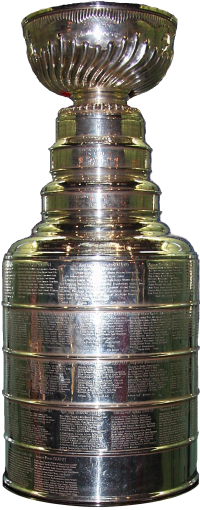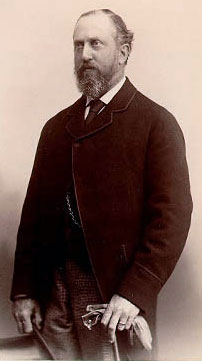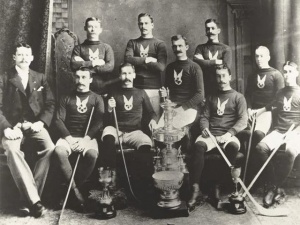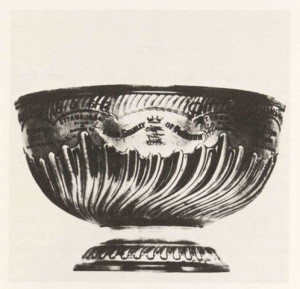Stanley Cup
The Stanley Cup (French: La Coupe Stanley) is the championship trophy awarded annually to the National Hockey League (NHL) playoff winner. Originally commissioned in 1892 as the Dominion Hockey Challenge Cup, the trophy is named for Lord Stanley of Preston, then–Governor General of Canada, who awarded it to Canada's top-ranking amateur ice hockey club, which the entire Stanley family supported, with the sons and daughters playing and promoting the game.
The first Cup was awarded in 1893 to Montreal HC, and subsequent winners from 1893 to 1914 were determined by challenge games and league play. Professional teams then became eligible to challenge for the Stanley Cup in 1906. In 1915, the two professional ice hockey organizations, the National Hockey Association (NHA) and the Pacific Coast Hockey Association (PCHA), reached a gentlemen's agreement in which their respective champions would face each other annually for the Stanley Cup.
After a series of league mergers and folds, it was established as the de facto championship trophy of the NHL in 1926 and then the de jure NHL championship prize in 1947.
There are actually three Stanley Cups: the original bowl of the "Dominion Hockey Challenge Cup", the authenticated "Presentation Cup", and the "Replica Cup" on display at the Hockey Hall of Fame. The NHL has maintained effective control over both the trophy itself and its associated trademarks. Nevertheless, the NHL does not actually own the trophy, but instead uses it by agreement with the two Trustees of the Cup. The NHL has registered trademarks associated with the name and likeness of the Stanley Cup, although the league's right to outright own trademarks associated with a trophy it does not own has been disputed by some legal experts.[3] The original bowl was made of silver and is 18.5 centimetres (7.28 inches) in height and 29 centimetres (11.42 inches) in diameter. The current Stanley Cup, topped with a copy of the original bowl, is made of a silver and nickel alloy; it has a height of 89.54 centimetres (35.25 inches) and weighs 15.5 kilograms (34.5 lb / 2 st 6½ lb).
Unlike the trophies awarded by the other major professional sports leagues of North America, a new Stanley Cup is not made each year; winners keep it until a new champion is crowned. It is unusual among trophies, in that it has the names of all of the winning players, coaches, management, and club staff engraved on its chalice. Initially, a new band added each year caused the trophy to grow in size, earning the nickname "Stovepipe Cup". In 1958 the modern one-piece Cup was designed with a five-band barrel which could contain 13 winning teams per band. To prevent the Stanley Cup from growing, when the bottom band is full, the oldest band is removed and preserved in the Hockey Hall of Fame, and a new blank band added to the bottom. It has been referred to as The Cup, Lord Stanley's Cup, The Holy Grail, or facetiously (chiefly by sportswriters) as Lord Stanley's Mug. The Stanley Cup is surrounded by numerous legends and traditions, the oldest of which is the celebratory drinking of champagne out of the cup by the winning team.
Since the 1914–15 season, the Cup has been won a combined 100 times by 18 active NHL teams and five defunct teams. Prior to that, the challenge cup was held by nine different teams. The Montreal Canadiens have won the Cup a record 24 times and are the most recent Canadian-based team to win the cup, having won it in 1993. The Stanley Cup was not awarded in 1919 because of a Spanish flu epidemic, and in 2005, as a consequence of the 2004–05 NHL lockout.
History
Origins
After the Lord Stanley of Preston was appointed by Queen Victoria as Governor General of Canada on June 11, 1888, he and his family became highly enthusiastic about ice hockey.[1] Stanley was first exposed to the game at Montreal's 1889 Winter Carnival, where he saw the Montreal Victorias play the Montreal Hockey Club.[2] The Montreal Gazette reported that he "expressed his great delight with the game of hockey and the expertise of the players".[1] During that time, organized ice hockey in Canada was still in its infancy and only Montreal and Ottawa had anything resembling leagues.[1]
Stanley's entire family became active in ice hockey. Two of his sons, Arthur and Algernon, formed a new team called the Ottawa Rideau Hall Rebels.[3] Arthur also played a key role in the formation of what later became known as the Ontario Hockey Association (OHA), and would go on to be the founder of ice hockey in Great Britain.[4] Arthur and Algernon persuaded their father to donate a trophy to be "an outward and visible sign of the hockey championship".[3] Stanley sent the following message to the victory celebration held on March 18, 1892, at Ottawa's Russell Hotel for the three-time champion Ottawa Hockey Club:[1][5][6]
I have for some time been thinking that it would be a good thing if there were a challenge cup which should be held from year to year by the champion hockey team in the Dominion [of Canada].
There does not appear to be any such outward sign of a championship at present, and considering the general interest which matches now elicit, and the importance of having the game played fairly and under rules generally recognized, I am willing to give a cup which shall be held from year to year by the winning team.
I am not quite certain that the present regulations governing the arrangement of matches give entire satisfaction, and it would be worth considering whether they could not be arranged so that each team would play once at home and once at the place where their opponents hail from.[5]
Soon afterwards, Stanley purchased what is frequently described as a decorative punch bowl, but which silver expert John Culme identified as a rose bowl,[7] made in Sheffield, England, and sold by London silversmith G. R. Collis and Company (now Boodle and Dunthorne Jewellers), for ten guineas, equal to ten and a half pounds sterling, US$48.67, which is equal to $1,282 in 2015 dollars.[1][8] He had the words "Dominion Hockey Challenge Cup" engraved on one side of the outside rim, and "From Stanley of Preston" on the other side.[9]
Originally, Stanley intended that the Cup should be awarded to the top amateur hockey team in Canada, to be decided by the acceptance of a challenge from another team. He made five preliminary regulations:[1][6]
- The winners shall return the Cup in good order when required by the trustees so that it may be handed over to any other team which may win it.
- Each winning team, at its own expense, may have the club name and year engraved on a silver ring fitted on the Cup.
- The Cup shall remain a challenge cup, and should not become the property of one team, even if won more than once.
- The trustees shall maintain absolute authority in all situations or disputes over the winner of the Cup.
- If one of the existing trustees resigns or drops out, the remaining trustee shall nominate a substitute.
Stanley appointed Sheriff John Sweetland and Philip D. Ross (who would serve in his post an unsurpassed 56 years) as trustees of the Cup. Sweetland and Ross first presented the trophy in 1893 to the Montreal Amateur Athletic Association on behalf of the affiliated Montreal Hockey Club, the champions of the Amateur Hockey Association of Canada (AHAC), since they "defeated all comers during the late season, including the champions of the Ontario Association" (Ottawa).[10] Sweetland and Ross also believed that the AHAC was the top league, and as first-place finishers in the AHAC, Montreal was the best team in Canada.[11] Naturally, the Ottawas were upset by the decision because there had been no challenge games scheduled and because the trustees failed to convey the rules on how the Cup was to be awarded prior to the start of the season.[11]
As a result, the Cup trustees issued more specific rules on how the trophy should be defended and awarded:[12][13]
- The Cup is automatically awarded to the team that wins the title of the previous Cup champion's league, without the need for any other special extra contest.
- Challengers for the Cup must be from senior hockey associations, and must have won their league championship. Challengers will be recognized in the order in which their request is received.
- The challenge games (where the Cup could change leagues) are to be decided either in a one-game affair, a two-game total goals affair, or a best of three series, to the benefit of both teams involved. All matches would take place on the home ice of the champions, although specific dates and times would have to be approved by the trustees.
- Ticket receipts from the challenge games are to be split equally between both teams.
- If the two competing clubs cannot agree to a referee, the trustees will appoint one, and the two teams shall cover the expenses equally. If the two competing clubs cannot agree on other officials, the referee will appoint them, and the two clubs shall also pay the expenses equally
- A league could not challenge for the Cup twice in one season.
Stanley never saw a Stanley Cup championship game, nor did he ever present the Cup. Although his term as Governor General ended in September 1893, he was forced to return to England on July 15. In April of that year, his elder brother Edward Stanley, 15th Earl of Derby died, and Stanley succeeded him as the 16th Earl of Derby.[4]
Challenge Cup era
Main article: List of Stanley Cup Challenge Games.
During the challenge cup period, none of the leagues that played for the trophy had a formal playoff system to decide their respective champions; whichever team finished in first place after the regular season won the league title. However, in 1894, four teams out of the five-team AHAC tied for the championship with records of 5–3–0. The AHAC had no tie-breaking system. After extensive negotiations and Quebec's withdrawal from the championship competition, it was decided that a three-team tournament would take place in Montreal, with the Ottawa team receiving a bye to the Final because they were the only road team. On March 17, in the first ever Stanley Cup playoff game, the Montreal Hockey Club (Montreal HC) defeated the Montreal Victorias, 3–2. Five days later, in the first Stanley Cup Final game, Montreal HC beat the Ottawa Hockey Club 3–1.[14][15]
In 1895, Queen's University was the first official challenger for the Cup, although it was controversial. The Montreal Victorias had won the league title and thus the Stanley Cup, but the challenge match was between the previous year's champion, Montreal HC, and the university squad. The trustees decided that if the Montreal HC won the challenge match, the Victorias would become the Stanley Cup champions. The Montreal HC won the match 5–1 and their cross-town rivals were crowned the champions.[16] The first successful challenge to the Cup came the next year by the Winnipeg Victorias, the champions of the Manitoba Hockey League. On February 14, 1896, the Winnipeg squad defeated the champions 2–0 and became the first team outside the AHAC to win the Cup.[17]
As the prestige of winning the Cup grew, so did the need to attract top players. Only nine months after winning the Cup, in March 1906, the Montreal Wanderers pushed through a resolution at the annual meeting of the Eastern Canada Amateur Hockey Association (ECAHA) that would allow professional players to play alongside amateurs. Because the ECAHA was the top hockey league in Canada at the time, the Cup trustees agreed to open the challenges to professional teams.[18] The first professional competition came one month later during the Wanderers' two-game, total goals challenge series, which they won 17 goals to 5.[19]
The smallest municipality to produce a Stanley Cup champion team is Kenora, Ontario; the town had a population of about 4,000 when the Kenora Thistles captured the Cup in January 1907.[20] Aided by future Hall of Famers Art Ross and "Bad" Joe Hall, the Thistles defeated the Montreal Wanderers in a two-game, total goals challenge series. The Thistles successfully defended the Cup once, against a team from Brandon, Manitoba. In March 1907, the Wanderers challenged the Thistles to a rematch. Despite an improved lineup, the Thistles lost the Cup to Montreal.
In 1908, the Allan Cup was introduced as the trophy for Canada's amateurs, and the Stanley Cup started to become a symbol of professional hockey supremacy.[18] In that same year, the first all-professional team, the Toronto Trolley Leaguers from the newly created Ontario Professional Hockey League (OPHL), competed for the Cup.[21] One year later, the Montreal HC and the Montreal Victorias, the two remaining amateur teams, left the ECAHA, and the ECAHA dropped "Amateur" from their name to become a professional league.[18] In 1910, the National Hockey Association (NHA) was formed. The NHA soon proved it was the best in Canada, as it kept the Cup for the next four years.[22]
Prior to 1912, challenges could take place at any time, given the appropriate rink conditions, and it was common for teams to defend the Cup numerous times during the year. In 1912, Cup trustees declared that it was only to be defended at the end of the champion team's regular season.[23]
Organized interleague competition
In 1914, the Victoria Aristocrats from the Pacific Coast Hockey Association (PCHA) challenged the NHA and Cup champion Toronto Blueshirts. A controversy erupted when a letter arrived from the Stanley Cup trustees on March 17, that the trustees would not let the Stanley Cup travel west, as they did not consider Victoria a proper challenger because they had not formally notified the trustees.[24] However, on March 18, Trustee William Foran stated that it was a misunderstanding. PCHA president Frank Patrick had not filed a challenge, because he had expected Emmett Quinn of the NHA to make all of the arrangements in his role as hockey commissioner, whereas the trustees thought they were being deliberately ignored. In any case, all arrangements had been ironed out and the Victoria challenge was accepted.[25][26]
Several days later, trustee Foran wrote to NHA president Quinn that the trustees are "perfectly satisfied to allow the representatives of the three pro leagues (NHA, PCHA, and Maritime) to make all arrangements each season as to the series of matches to be played for the Cup."[27] One year later, the NHA and the PCHA concluded a gentlemen's agreement in which their respective champions would face each other for the Cup. Under the new proposal, the Stanley Cup Final series alternated between the East and the West each year, with alternating games played according to NHA and PCHA rules.[28] The PCHA's Vancouver Millionaires won the 1915 series three games to none in a best-of-five series.[29]
After the Portland Rosebuds, an American-based team, joined the PCHA in 1914, the trustees issued a statement that the Cup was no longer for the best team in Canada, but now for the best team in the world.[28] Two years later, the Rosebuds became the first American team to play in the Stanley Cup Final.[30] In 1917, the Seattle Metropolitans became the first American team to win the Cup.[31] After that season, the NHA dissolved, and the National Hockey League (NHL) took its place.[28]
In 1919, the Spanish influenza epidemic forced the Montreal Canadiens and the Seattle Metropolitans to cancel their series, marking the first time the Stanley Cup was not awarded.[32] The series was tied at 2–2–1, but the final game was never played because Montreal Manager George Kennedy and players Joe Hall, Billy Coutu, Jack McDonald, and Newsy Lalonde were hospitalized with influenza. Hall died four days after the cancelled game, and the series was abandoned.[33]
The format for the Stanley Cup Final changed in 1922, with the creation of the Western Canada Hockey League (WCHL). Three leagues competed for the Cup: two league champions faced each other for the right to challenge the third champion in the final series.[34] This lasted three seasons as the PCHA and the WCHL later merged to form the Western Hockey League (WHL) in 1925.[35] After winning in the 1924–25 season, the Victoria Cougars became the last team outside the NHL to win the Stanley Cup.[36]
NHL takes over
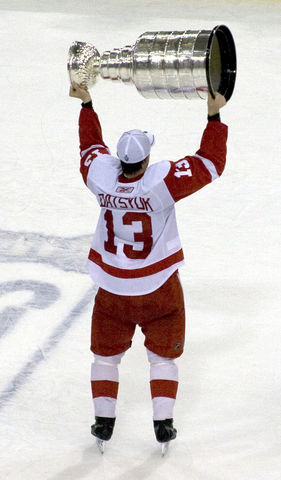
The WHL folded in 1926, leaving the NHL as the only league left competing for the Cup. Other leagues and clubs occasionally issued challenges, but from that year forward, no non-NHL team has played for it, leading it to become the de facto championship trophy of the NHL.[35][37] In 1947, the NHL reached an agreement with trustees P.D. Ross and Cooper Smeaton to grant control of the Cup to the NHL, allowing the league to reject challenges from other leagues that may have wished to play for the Cup.[37][38][39]
- The Trustees hereby delegate to the League full authority to determine and amend from time to time the conditions for competition of the Stanley Cup, including the qualifications of challengers, the appointment of officials, the apportionment and distribution of all gate receipts, provided always that the winners of this trophy shall be the acknowledged World's Professional Hockey Champions.
- The Trustees agree that during the currency of this agreement they will not acknowledge or accept any challenge for the Stanley Cup unless such a challenge is in conformity with the condition specified in paragraph one (1) thereof.
- The League undertakes the responsibility for the care and safe custody of the Stanley Cup including all necessary repairs and alterations to the cup and sub-structure as may be required from time to time, and further undertakes to insure the Stanley Cup for its full insurable value.
- The League hereby acknowledges itself to be bound to the Trustees in the sum of One Thousand Dollars, which bond is conditioned upon the safe return of the Stanley Cup to the Trustees in accordance with the terms of this Agreement, and it is agreed that the League shall have the right to return the trophy to the Trustees at any time.
- This agreement shall remain in force so long as the League continues to be the world's leading professional hockey league as determined by its playing caliber, and in the event of dissolution or other termination of the National Hockey League, the Stanley Cup shall revert to the custody of the trustees.
- In the event of default in the appointment of a new trustee by the surviving trustee, the "Trustees" hereby delegate and appoint the Governors of the International Hockey Hall of Fame in Kingston, Ontario, to name two Canadian trustees to carry on under the terms of the original trust, and in conformity with this Agreement.
- And it is further mutually agreed that any disputes arising as to the interpretation of this Agreement or the facts upon which such interpretation is made, shall be settled by an Arbitration Board of three, one member to be appointed by each of the parties, and the third to be selected by the two appointees. The decision of the Arbitration Board shall be final.[13]
This agreement was amended on November 22, 1961, substituting the Governors of the International Hockey Hall of Fame in Kingston, Ontario with the Committee of the Hockey Hall of Fame in Toronto, Ontario as the group that would name the two Canadian trustees, if need be. In the 1970s, the World Hockey Association sought to challenge for the Cup – the Trustees denied them the opportunity to do so. However, notwithstanding the aforementioned legal obligation, the NHL quietly discontinued calling its champions the "world champions" during this time, largely in order to avoid having its champion incur at least a moral obligation to play the WHA champion.
The Cup was awarded every year until 2005, when a labour dispute between the NHL's owners and the NHL Players Association (the union that represents the players) led to the cancellation of the 2004–05 season. As a result, no Cup champion was crowned for the first time since the flu pandemic in 1919. The lockout was controversial among many fans, who questioned whether the NHL had exclusive control over the Cup. A website known as freestanley.com (since closed) was launched, asking fans to write to the Cup trustees and urge them to return to the original Challenge Cup format.[40] Adrienne Clarkson, then Governor General of Canada, alternately proposed that the Cup be presented to the top women's hockey team in lieu of the NHL season. This idea was so unpopular that the Clarkson Cup was created instead. Meanwhile, a group in Ontario, also known as the "Wednesday Nighters", filed an application with the Ontario Superior Court, claiming that the Cup trustees had overstepped their bounds in signing the 1947 agreement with the NHL, and therefore must award the trophy regardless of the lockout.[41]
On February 7, 2006, a settlement was reached in which the trophy could be awarded to non-NHL teams should the league not operate for a season. The dispute lasted so long that, by the time it was settled, the NHL had resumed operating for the 2005–06 season, and the Stanley Cup went unclaimed for the 2004–05 season.[39] Furthermore, when another NHL lockout commenced in 2012 the Trustees stated that the 2006 agreement did not oblige them to award the Cup in the event of a lost season, and that they were likely to reject any non-NHL challenges for the Cup in the event the 2012–13 season were cancelled, which it was not.
Champions
References
- ↑ 1.0 1.1 1.2 1.3 1.4 1.5 Podnieks 2004, p. 3.
- ↑ "Hockey Hall of Fame: Stanley Cup Journals 01". http://www.hhof.com/htmlstcjournal/exSCJ07_01.shtml. Retrieved May 13, 2008.
- ↑ 3.0 3.1 Diamond 1992, p. 10.
- ↑ 4.0 4.1 Diamond, Zweig & Duplacey 2003, p. 11.
- ↑ 5.0 5.1 "Ottawa Journal article of dinner at Backcheck web site". Library and Archives Canada. http://www.collectionscanada.ca/hockey/024002-119.01-e.php?&hockey_id_nbr=6&&PHPSESSID=rq9jcm5ucr4uim576lt6808ik4. Retrieved November 3, 2007.
- ↑ 6.0 6.1 "The Stanley Cup". NHL. http://www.nhl.com/cup/cup.html. Retrieved July 11, 2006.
- ↑ Potter, Mitch. "Cup runneth over with cousins", Toronto Star, May 24, 2008. Retrieved on June 10, 2015.
- ↑ "Unraveling the mystery of Stanley". NHL. http://www.nhl.com/cup/cupearly.html. Retrieved July 11, 2006.
- ↑ Zweig 2012, p. 15.
- ↑ Diamond 1992, p. 14.
- ↑ 11.0 11.1 Podnieks 2004, p. 4.
- ↑ Diamond, Zweig & Duplacey 2003, pp. 17–18.
- ↑ 13.0 13.1 Podnieks 2004, p. 5.
- ↑ Podnieks 2004, p. 20.
- ↑ "Stanley Cup Winners: Montreal AAA 1893–94". Hockey Hall of Fame. Archived from the original on September 30, 2007. https://web.archive.org/web/20070930080711/http://www.legendsofhockey.net:8080/LegendsOfHockey/jsp/SilverwareTrophyWinner.jsp?tro=STC&year=1893-94. Retrieved July 11, 2006.
- ↑ "Stanley Cup Winners: Montreal Victorias 1894–95". Hockey Hall of Fame. Archived from the original on March 7, 2008. https://web.archive.org/web/20080307224825/http://www.legendsofhockey.net:8080/LegendsOfHockey/jsp/SilverwareTrophyWinner.jsp?tro=STC&year=1894-95. Retrieved July 11, 2006.
- ↑ "Stanley Cup Winners: Winnipeg Victorias 1895–96Feb". Hockey Hall of Fame. Archived from the original on September 30, 2007. https://web.archive.org/web/20070930080341/http://www.legendsofhockey.net:8080/LegendsOfHockey/jsp/SilverwareTrophyWinner.jsp?tro=STC&year=1895-96Feb. Retrieved July 11, 2006.
- ↑ 18.0 18.1 18.2 Diamond, Zweig & Duplacey 2003, p. 19.
- ↑ Podnieks 2004, p. 37.
- ↑ "Stanley Cup Winners: Kenora Thistles 1906–07Jan". Hockey Hall of Fame. Archived from the original on November 23, 2005. https://web.archive.org/web/20051123215217/http://www.legendsofhockey.net:8080/LegendsOfHockey/jsp/SilverwareTrophyWinner.jsp?tro=STC&year=1906-07Jan. Retrieved July 24, 2006.
- ↑ Diamond 1992, p. 38.
- ↑ Diamond, Zweig & Duplacey 2003, p. 24.
- ↑ "Stanley Cup Winners: Quebec Bulldogs 1911–12". Hockey Hall of Fame. Archived from the original on June 10, 2008. https://web.archive.org/web/20080610202322/http://www.legendsofhockey.net:8080/LegendsOfHockey/jsp/SilverwareTrophyWinner.jsp?tro=STC&year=1911-12. Retrieved July 11, 2006.
- ↑ "Stanley Cup Contest May Not Be for the Mug, After All is Said", Saskatoon Phoenix, March 18, 1914, p. 8.
- ↑ "A Tempest In a Teapot", Montreal Daily Mail, March 19, 1914, p. 9.
- ↑ "Stanley Cup Muddle Cleared Up", Toronto Globe and Mail, March 19, 1914.
- ↑ "Three Pro Leagues as to Stanley Cup", Toronto World, March 25, 1914, p. 8.
- ↑ 28.0 28.1 28.2 Diamond, Zweig & Duplacey 2003, p. 20.
- ↑ "Stanley Cup Winners: Vancouver Millionaires 1914–15". Hockey Hall of Fame. Archived from the original on April 9, 2006. https://web.archive.org/web/20060409051041/http://www.legendsofhockey.net:8080/LegendsOfHockey/jsp/SilverwareTrophyWinner.jsp?tro=STC&year=1914-15. Retrieved July 11, 2006.
- ↑ Diamond 1992, p. 46.
- ↑ "Stanley Cup Winners: Seattle Metropolitans 1916–17". Hockey Hall of Fame. Archived from the original on September 30, 2007. https://web.archive.org/web/20070930080630/http://www.legendsofhockey.net:8080/LegendsOfHockey/jsp/SilverwareTrophyWinner.jsp?tro=STC&year=1916-17. Retrieved July 11, 2006.
- ↑ Podnieks 2004, p. 51.
- ↑ Diamond 1992, pp. 51–52.
- ↑ Diamond, Zweig & Duplacey 2003, pp. 20–21.
- ↑ 35.0 35.1 Diamond, Zweig & Duplacey 2003, p. 21.
- ↑ "Stanley Cup Winners: Victoria Cougars 1924–25". Hockey Hall of Fame. Archived from the original on September 30, 2007. https://web.archive.org/web/20070930080728/http://www.legendsofhockey.net:8080/LegendsOfHockey/jsp/SilverwareTrophyWinner.jsp?tro=STC&year=1924-25. Retrieved July 11, 2006.
- ↑ 37.0 37.1 Kreiser, John (March 18, 2013). "Stanley Cup timeline, from 1892 to today". National Hockey League. https://www.nhl.com/news/stanley-cup-timeline-from-1892-to-today/c-660570. Retrieved June 21, 2016.
- ↑ Diamond, Zweig & Duplacey 2003, p. 40.
- ↑ 39.0 39.1 "Court:Non-NHL teams could vie for Cup". TSN. February 7, 2006. Archived from the original on December 16, 2007. https://web.archive.org/web/20071216083200/http://www.tsn.ca/nhl/news_story/?ID=153935&hubname=. Retrieved July 15, 2006.
- ↑ "Lockout Reminds Lowe of Gretzky Deal". TSN. February 16, 2005. Archived from the original on September 29, 2007. https://web.archive.org/web/20070929162525/http://www.tsn.ca/nhl/news_story/?ID=115156&hubname=. Retrieved July 15, 2006.
- ↑ "Amateurs taking NHL to court to play for Cup". ESPN. April 13, 2005. http://sports.espn.go.com/nhl/news/story?id=2036537. Retrieved October 13, 2007.
External links
| This page uses Creative Commons Licensed content from Wikipedia (view authors). |
